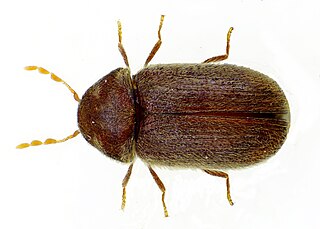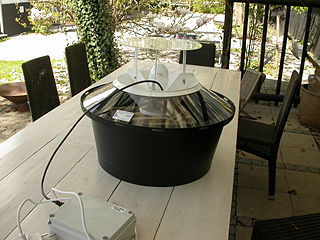
Bookworm is a general name for any insect that is said to bore through books.

Darkling beetle is the common name for members of the beetle family Tenebrionidae. The number of species in the Tenebrionidae is estimated at more than 20,000 and the family is cosmopolitan in distribution.

The drugstore beetle, also known as the bread beetle, biscuit beetle, and misnamed as the biscuit weevil, is a tiny, brown beetle that can be found infesting a wide variety of dried plant products, where it is among the most common non-weevils to be found. It is the only living member of the genus Stegobium. It belongs to the family Ptinidae, which also includes the deathwatch beetle and furniture beetle.

The khapra beetle, also called cabinet beetle, which originated in South Asia, is one of the world's most destructive pests of grain products and seeds. It is considered one of the 100 worst invasive species in the world. Infestations are difficult to control because of the insect's ability to survive without food for long periods, its preference for dry conditions and low-moisture food, and its resistance to many insecticides. There is a federal quarantine restricting the importation of rice into the U.S. from countries with known infestations of the beetle. Khapra beetle infestation can spoil otherwise valuable trade goods and threaten significant economic losses if introduced to a new area. Handling or consuming contaminated grain and seed products can lead to health issues such as skin irritation and gastrointestinal distress.

The Mediterranean flour moth or mill moth is a moth of the family Pyralidae. It is a common pest of cereal grains, especially flour. This moth is found throughout the world, especially in countries with temperate climates. It prefers warm temperatures for more rapid development, but it can survive a wide range of temperatures.

Oryzaephilus surinamensis, the sawtoothed grain beetle, is a beetle in the superfamily Cucujoidea. It is a common, worldwide pest of grain and grain products as well as chocolate, drugs, and tobacco. The species' binomial name, meaning "rice-lover from Suriname," was coined by Carl Linnaeus, who received specimens of the beetle from Surinam. It is also known as the malt beetle and may be referenced in the poem This Is The House That Jack Built in the line "....the rat that ate the malt that lay in the house that Jack built" the malt referenced may not be actual malted grain but a sawtoothed grain beetle.

The foreign grain beetle is a species of beetle in the family Silvanidae. It is related to the sawtoothed grain beetle.

Flour beetles are members of the darkling beetle genera Tribolium or Tenebrio. They are pests of cereal silos and are widely used as laboratory animals, as they are easy to keep. The flour beetles consume wheat and other grains, are adapted to survive in very dry environments, and can withstand even higher amounts of radiation than cockroaches. They are a major pest in the agricultural industry and are highly resistant to insecticides.
Home-stored product entomology is the study of insects which infest foodstuffs stored in the home. It deals with the prevention, detection and eradication of the pests. The five major categories of insects considered in this article are flour beetles, the drugstore beetle, the sawtoothed grain beetle, the Indianmeal moth and fruit flies.

The confused flour beetle, a type of darkling beetle known as a flour beetle, is a common pest insect known for attacking and infesting stored flour and grain. They are one of the most common and most destructive insect pests for grain and other food products stored in silos, warehouses, grocery stores, and homes.

Tenebrioninae is the largest subfamily of the darkling beetles (Tenebrionidae), containing flour beetles, among others. Tenebrioninae contains more than 20 tribes.

The red flour beetle is a species of beetle in the family Tenebrionidae, the darkling beetles. It is a worldwide pest of stored products, particularly food grains, and a model organism for ethological and food safety research.

Rhyzopertha is a monotypic genus of beetles in the family Bostrichidae, the false powderpost beetles. The sole species, Rhyzopertha dominica, is known commonly as the lesser grain borer, American wheat weevil, Australian wheat weevil, and stored grain borer. It is a beetle commonly found within store bought products and pest of stored cereal grains located worldwide. It is also a major pest of peanuts. The first documentation of wheat infestation by R. dominica was observed in Australia. R. dominica are usually reddish brown to dark brown in coloration, vary in sizes, elongated and cylindrical.

The maize weevil, known in the United States as the greater rice weevil, is a species of beetle in the family Curculionidae. It can be found in numerous tropical areas around the world, and in the United States, and is a major pest of maize. This species attacks both standing crops and stored cereal products, including wheat, rice, sorghum, oats, barley, rye, buckwheat, peas, and cottonseed. The maize weevil also infests other types of stored, processed cereal products such as pasta, cassava, and various coarse, milled grains. It has even been known to attack fruit while in storage, such as apples.

Moth traps are devices used for capturing moths for scientific research or domestic pest control.

Anthrenocerus australis is a species of beetle belonging to the Dermestidae family. It is commonly known as the Australian carpet beetle and is one of the most researched of the thirty-one species in the Anthrenocerus genus. This is generally attributed to its prevalence throughout Australia and New Zealand and the negative economic and agricultural impact it has as a pest. It is the larvae that causes damage to products, not the adult beetle. The total life cycle of this insect is around three years, most of which is spent as a larva. Once the beetle reaches maturity, it only lives for between two and six weeks.

Tribolium is a genus of flour beetles in the family Tenebrionidae. They are known by various common names including flour beetles, flour weevils, red weevils and bran bugs.

Latheticus oryzae is a species of beetle.
A storage pest is an insect or other animal that damages or destroys stored food or other stored valuable organic matter. Insects are a large proportion of storage pests with each type of crop having specific insects that gravitate towards them such as the genus Tribolium that consists of insects such as Tribolium castaneum or Tribolium confusum which damage flour crops primarily.
Aphanotus brevicornis, the North American flour beetle, is a species of flour beetle in the family Tenebrionidae. It is a pest of stored foodstuff, particularly processed grains.
















